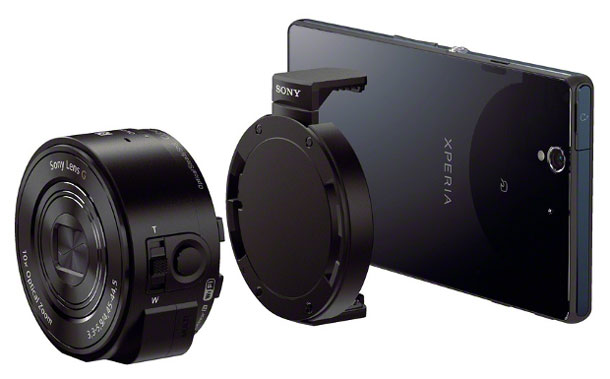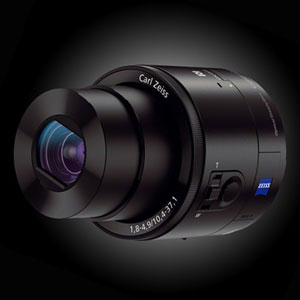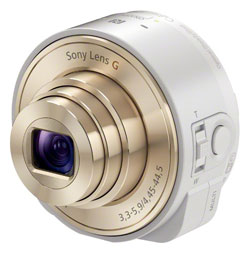

The less powerful Cyber-shot QX10 has a smaller 18MP CMOS sensor. It’s more lightweight than its fancier sibling, but it does have a 10x optical zoom Sony G lens. Neither have a flash; both work with microSD cards.
The official Sony promotion clip below offers a glimpse at how Sony envisions consumers using these peculiar and as unconventional as ingenious new products. It costs quite an effort to think this could work for a “classic” photographer. It’s the answer to the dying digital compact camera market. The sky’s the limit, really. You can either attach these lens cameras via spring-loaded holder to your smartphone of choice — or use them separated from the mobile device. In the case of the QX100 that becomes a remotely controlled, fast F1.8 Zeiss at your fingertips… Just use the PlayMemories Mobile app to control the lens.

The QX concept makes the image quality of the often belittled smartphone photography top notch. No smartphone camera or lens kit can compete with the QX.
Read our definitive, continuously updated Sony QX10 and QX100 Reference File bringing you all the relevant QX hands-on reviews and field reports that matter (latest update on top).
+++ You can order the black QX100 from Amazon (or B&H / Adorama) for $498. Also available is the QX10 for $248 in black (Amazon / B&H / Adorama) or white (Amazon / B&H / Adorama). Soft carrying cases are $33 for the QX100 and $23 for the QX10.
Android Police offers a substantial review — verdict:
I recently saw a commenter noting — on another review of the QX10 — that “if it works as well as a DSLR,” they’d have no qualms about toting around Sony’s camera-in-lens contraption.
That’s kind of the sticking point with the QX10 though — what does it mean to “work well?” For some, that means image quality, for others that means the controls, tuning, time-to-shoot and overall creative freedom you’d expect in a single lens reflex. If you’re the former, the QX10 will meet your expectation. The latter? No way.
Even if you’re only after image quality, the other question any potential buyer must ask of themselves is “will I want to carry this thing around?”
If you’ve got the spare space in your purse or bag, I say go for it. As the title of this review suggests, I see the QX10 as yet another stepping stone between mobile phone cameras and DSLRs.
If you don’t like point-and-shoot cameras for some reason, can’t stand your phone’s camera and want something that’ll give you decent images on the go, the QX10 probably fits. Just realize that you still won’t be capturing those fleeting picture-perfect moments in 18 megapixels — you’ll be too busy setting the QX10 up.
The New York Times‘ David Pogue on this “whole new idea — half a camera”:
Sony’s masterstroke: Why not create a weird new half-a-camera that contains exactly the components that a cell phone camera lacks?
It could have a lens that really zooms. It could contain serious, professional “glass” — a Zeiss F1.8 lens, with the quality, multiple glass elements and light-passing capacity that cell phones wouldn’t have in their wildest dreams. It could have manual controls, optical image stabilization and a tripod mount.
Above all, it could have a huge sensor, the digital “film.” This sensor could measure one inch diagonal — over 40 times the size of a cell phone’s sensor (…)
In the end, the compromises and lag and rough edges of the QX lens cameras wind up sabotaging much of what makes the idea so brilliant.
But listen: let’s not mope. Let’s celebrate the spirit of that spectacular central idea, the master engineers who brought it to life and even the executives who greenlighted this crazy, offbeat product. Let’s hope that spirit survives long enough for us to see a QX 2.0 next year.
Reviewed has a look at the QX10 module, well it’s not all milk and honey:
The QX10’s image quality is better than your smartphone’s, yes, but not by much. The biggest gain is in terms of optical zoom, but the camera’s awkward handling makes actually utilizing that 10x telephoto a challenge. And while the QX10’s pairing behavior and user interface are better (or at least less convoluted) than any other WiFi implementation we’ve seen, shooting with the app still felt arbitrarily limiting — almost like a chore.
Smartphone photography is all about having a tool that lets you capture the moment without stepping outside of it, and most smartphones already meet that criteria. They’re simple, reliable, and always on hand. In terms of pure imaging chops, the QX10 is a better tool, but it’s not as convenient a solution to that basic need. From a practicality perspective it’s just another device you have to carry around with you — no different in that regard than a dedicated compact camera. And it’s great that it hooks up directly with your phone, but the mandatory PlayMemories app is just another middleman between you and the social network of your choice.
Expert Reviews got their hands on the QX — and they like the “little serious picture taking package”:
This is a serious camera and arguably a huge upgrade to any smartphone camera bar possibly the Nokia Lumia 1020 with its PureView sensor. The QX10 has numerous exposure settings for those who like to tinker, and there’s even a control ring around the lens that you can assign to various settings.
BGR‘s first impressions:
I recently spent some hands-on time with both of Sony’s new Cyber-shot smartphone accessories and I came away impressed. Of course it’s important to first note that these are not mass-market devices Sony expects average consumers to purchase. The QX10 and QX100 are specialized devices aimed directly at big-time photography enthusiasts, and they are intended to bridge the gap between a smartphone and a DSLR. If you pretty much only use your phone to take selfies, snap pictures of sunsets and occasionally capture photos of your dinner, these accessories are not for you (…)
Using the devices is remarkably simple, especially if you own a Sony smartphone. Simply open the companion app, tap the lens to the phone to initiate the near-instant NFC pairing, and clip the lens to the back of your smartphone. That’s it. Connections must me made manually on devices like the iPhone that don’t have NFC, but it only takes a few extra seconds.
Says hardly excited CNET:
For the QX100, you lose a lot of features and functionality of the RX100 II including raw image capture, a flash and a hot shoe, several shooting options including full manual control, much better video quality, and physical controls.
You still have to carry around a second device (that’s not as easily pocketable as the RX100 II), and now you have two battery lives to worry about: the camera’s and your smartphone’s. And although you can turn it on and shoot without pairing, you have to pair it to actually see what you’re shooting or change any settings. Not to mention a lengthy startup time of 6.9 seconds.
The QX10 makes a bit more sense because it’s smaller, less expensive, and designed more for casual photographers who want some zoom range to supplement their smartphone photography.
But, again, it’s still a second device and that’s not what people want. They want these features — zoom lenses, better photo quality, etc. — in their smartphones.
All Things D calls the CX series a “head-scratcher of a camera” — “Sony didn’t want to “make an RX100 that can text and browse,” as one Sony executive said…:
The lens is meant to wirelessly connect and physically attach, via a spring-loaded holder, to various smartphones — namely, iPhones and certain Android devices. The lens-style camera becomes a Wi-Fi access point, while the phone acts as the viewfinder, through a Sony camera app.
The end result? Your pretty-decent smartphone camera is transformed into a midrange camera with the help of a pocket-sized lens.
It’s either really nifty or a total gimmick.
DP Review‘s early verdict on using the QX100:
What Sony’s engineers have done in the QX100 is certainly bold. Repackaging the guts from a flagship point-and-shoot in a made-for-mobile device is an unprecedented move. It’s also a bold approach to the problem of a camera’s relative lack of connectivity — rather than fighting the smartphone, the QX100 joins the smartphone. Or rather is conjoined with it.
What still hasn’t been solved is the problem of carrying two devices. Carrying a smartphone and a point-and-shoot is more than most people are willing to do, and the QX100 is actually less pocketable than many small compacts, because of its bulky cylindrical shape. Plus the QX100 is too big and heavy to realistically leave it coupled to a smartphone for an extended amount of time.
With its high-end specs and a high price to match, Sony seems to be hoping that the QX100 user is the type of person who doesn’t mind carrying two devices if together they’ll do something unique — capture great images which are instantly sharable. There’s no doubt that the QX100 packs a lot of technology inside it. However, controls are stripped down, there’s no option to shoot Raw and basic settings like ISO are unavailable to the user. That’s likely going to put off a lot of potential buyers. Raw shooting especially is a feature we think would greatly increase the appeal of the QX100 to an enthusiast crowd, so we hope Sony will consider adding it in a firmware update.
Consider that the QX100 also strips away a flash, AF assist lamp, manual focus aids and manual exposure control (you have aperture priority and exposure compensation but that’s all) and it’s hard to imagine the enthusiast shooter who would be better served by this camera rather than a full-fledged compact. Still, the achievement stands as one of the most interesting compact camera announcements of the year, and we’re curious to see how it is received by consumers.
Says Pop Photo:
One of the coolest things about the QX cameras is the range they offer. You can keep the phone in your pocket if you’re confident in your framing skills. Or, you can hold the camera unit at weird angles while previewing it on the phone.
I have to admit that holding these in my hand piqued my interest much more than I expected. The prospect of using the built-in tripod socket to stick these things in spots and control them with my phone in real time is very appealing. The idea of going way beyond an articulating screen in terms of flexibility could be very useful (…)
The idea reminds me a bit of the idea behind Ricoh’s GXR camera, which used a static body with interchangeable modules that included a lens mount, sensor and processor. It would be interesting if Sony could bring this into the world of the NEX cameras. That might be wishful thinking, but who knows what’s going to happen at this point.
DP Review Connect has a first look at the QX system. Early impressions:
The Sony Cyber-shot DSC-QX10 and QX100 offer a totally new way of shooting on your mobile device. These cameras leave the world of tiny sensors and fixed lenses behind, offering you a choice of high zoom power or excellent photo quality. But are they worth the price?
The QX10 is the cheaper of the two cameras ($250), and features an 18-megapixel sensor and a 10X optical zoom lens. Sure that’s more pixels than any smartphone — aside from a few Nokias — but will the typical smartphone user notice the difference? As for the zoom, you can pick up teleconverters such as this one for a lot less that the QX10. Sure, you can’t zoom in and out, nor will the image quality be as good, but $35 is a lot cheaper than $250.
While it’s based on the RX100 II, the QX100 is a bit underwhelming. On the positive side, it offers the same high-quality lens and sensor as the camera on which it is based. That said, it’s missing quite a few features, including shutter priority and manual exposure modes, adjustable ISO sensitivity, Raw support, and Full HD video. Add in the bulk and the price ($500) and you might be wondering if you should just carry around a premium compact camera instead.
Amateur Photographer fears the QX gadgets will escalate camera wars. Bad news?!
Sony will launch a new PlayMemories software application that enables the phone to simulate the interface of a camera. This means users should be able to control settings such as exposure compensation and aperture, and share images via apps installed on the smartphone.
“Everything is easily accessible, with extra dedicated keys or fingertip control of zoom and shutter release on the camera body,” claims Sony.
The QX10 and QX100 are also compatible with Near Field Communication, a wireless system designed to allow “one-touch” connection between devices.
The Phoblographer‘s first QX thoughts:
We think that Sony needs to be given a lot of credit. Years ago, they told us flat out that they took a major hit in the digital imaging division because of smartphones–but most of that was centered around point and shoots. To adapt, they started to focus more on their interchangeable lens and larger sensor cameras. To adapt even further, they decided to embrace the smartphone market rather than fight it. And with their new QX10 and QX100 units, they surely will be able to. Users will be able to give their phone a real optical zoom and get some glorious bokeh and significantly better high ISO imagery with the units if used correctly.
Though we haven’t been loaned official review units yet, Sony needs to be commended for adapting and surely taking a risk. If the first generation of these products isn’t successful, the second one might be.
Imaging Resource, not fully convinced, on the QX100:
These devices are the first of many such that we’ll see, and as the pioneer products in this space, they have a few entirely-to-be-expected rough edges. Despite the QX10’s lack of camera controls, it is in fact extremely compact, slipping very easily into even the smallest pockets. That, combined with its relatively low selling price should result in a fair number of sales for it. The opportunity to get not only better image quality, but a 10x zoom, all well-integrated with your cell phone or smart device should be a compelling value proposition for a lot of people.
SonyAlphaRumors says even before launch, QX is already the most preordered Sony camera in history that is about to break all (Sony) records.
+++ You can order the black QX100 from Amazon (or B&H / Adorama) for $498. Also available is the QX10 for $248 in black (Amazon / B&H / Adorama) or white (Amazon / B&H / Adorama). Soft carrying cases are $33 for the QX100 and $23 for the QX10.


